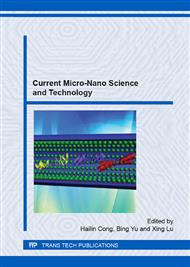[1]
R.L. McGinnis, M. Elimelech, Global challenges in energy and water supply: The promise of engineered osmosis, Environ. Sci. Technol. 42 (2008) 8625-8629.
DOI: 10.1021/es800812m
Google Scholar
[2]
H. Ma, C. Burger, B.S. Hsiao, B. Chu, Nanofibrous microfiltration membrane based on cellulose nanowhiskers, Biomacromolecules. 13 (2011) 180-186.
DOI: 10.1021/bm201421g
Google Scholar
[3]
L. Huang, N.N. Bui, M.T. Meyering, T.J. Hamlin, J.R. McCutcheon, Novel hydrophilic nylon 6, 6 microfiltration membrane supported thin film composite membranes for engineered osmosis, J. Membrane Sci. 437 (2013) 141-149.
DOI: 10.1016/j.memsci.2013.01.046
Google Scholar
[4]
M.G. Buonomenna, Membrane processes for a sustainable industrial growth, Rsc. Adv. 3 (2013) 5694-5740.
DOI: 10.1039/c2ra22580h
Google Scholar
[5]
X. Li, X.F. Fang, R.Z. Pang, J.S. Li, X.Y. Sun, J.Y. Shen, W.Q. Han, L.J. Wang, Self-assembly of TiO2 nanoparticles around the pores of PES ultrafiltration membrane for mitigating organic fouling. J. Membrane Sci. 467 (2014) 226-235.
DOI: 10.1016/j.memsci.2014.05.036
Google Scholar
[6]
W. Gao, H. Liang, J. Ma, M. Han, Z.L. Chen, Z.S. Han, G. B Li, Membrane fouling control in ultrafiltration technology for drinking water production: a review. Desalination. 272 (2011) 1-8.
DOI: 10.1016/j.desal.2011.01.051
Google Scholar
[7]
X. Zhang, C. Li, Y. Wang, J. Luo, T. Xu, Recovery of acetic acid from simulated acetaldehyde wastewaters: Bipolar membrane electrodialysis processes and membrane selection. Journal of Membrane Science. 379 (2011) 184-190.
DOI: 10.1016/j.memsci.2011.05.059
Google Scholar
[8]
Y. Tanaka, S.H. Moon, V.V. Nikonenko, T. Xu, Ion-Exchange Membranes. Inter. J. Chem. Eng. 1 (2012) 2012-(2014).
Google Scholar
[9]
H.L. Cong, J.L. Wang, B. Yu, J.G. Tang, Preparation of a highly permeable ordered porous microfiltration membrane of brominated poly(phenylene oxide) on an ice substrate by the breath figure method, Soft Matter. 8 (2012) 3335-8839.
DOI: 10.1039/c2sm25706h
Google Scholar
[10]
G. Widawski, M. Rawiso, B. Francois, Nature. 369 (1994) 387.
Google Scholar
[11]
Y. Gao, Y. Huang, S. Xu, W. Ouyang, Y. Jiang, Langmuir. 27 (2011) 2958.
Google Scholar
[12]
T. Xu, D. Wu, L. Wu. Poly(2, 6-dimethyl-1, 4-phenylene oxide) (PPO)-a versatile starting polymer for proton conductive membranes (PCMs). Progress in Polymer Science. 33 (2008), 894-915.
DOI: 10.1016/j.progpolymsci.2008.07.002
Google Scholar
[13]
M. White, B. R. Strazisar, E. J. Granite, J. S. Joffman, H.W.J. Pennline, Separation and capture of CO2 from large stationary sources and sequestration in geological formations-coal beds and deep saline aquifers. J. Air Waste Manage. Assoc. 53 (2003).
DOI: 10.1080/10473289.2003.10466206
Google Scholar
[14]
X. Hu, H. Cong, Y. Shen, M. Radosz. Nanocomposite membranes for CO2 separations: Silica/brominated poly(phenylene oxide). Ind. Eng. Chem. Res. 46 (2007) 1547-1551.
DOI: 10.1021/ie061055y
Google Scholar


